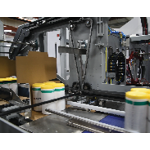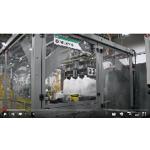It was not long ago that RSC top load was the dominant style of case packing within the food industry for sauces, dressings, condiments, and other products packaged in bottles or jars. However, in the past several years the push for machine flexibility and the … [Read More...] about Case Packing Sauces, Dressings or Condiments? Consider a Wraparound Solution
Main Content
Empowering the Next Generation of Women Packaging Leaders
After spending time this month with a talented, dynamic group of women, I’m more confident than ever about the opportunities in front of us in packaging. I, along with four other women from Brenton and Orion, attended the PowHER of the Pack annual meeting, … [Read More...] about Empowering the Next Generation of Women Packaging Leaders
Lending a Helping Hand to Your Secondary Packaging
Hand-packing will only get you so far. As companies grow and production rates rise, automation becomes an attractive option for their end-of-line packaging. Even for those who have previously automated their lines for existing applications, if factors … [Read More...] about Lending a Helping Hand to Your Secondary Packaging
Is Your End of Arm Tooling Flexible? Here is Why it Should Be
The right end-of-arm tooling (EOAT) to pair with your robotic palletizing system is one that is flexible to accommodate diverse products, while also engineered to provide a strong return on investment. EOAT today is designed to do more than simply lift and … [Read More...] about Is Your End of Arm Tooling Flexible? Here is Why it Should Be
Brenton Names Lanel Menezes as Vice President of Sales
ALEXANDRIA, Minn., August 16, 2023 – Lanel Menezes has been named Vice President of Sales for Brenton, a role in which he will be promoting the brand’s products and services, developing strategic plans for growth, forging customer relationships, leading sales … [Read More...] about Brenton Names Lanel Menezes as Vice President of Sales

See Fast, Trouble-Free Changeovers with the New XCP Series Case Packer in Booth C-3822 at PACK EXPO 2023
Brenton demonstrates the new XCP Series continuous motion case packer, and its robotic expertise with an integrated line in Las Vegas. ALEXANDRIA, Minn., August 9, 2023 – While it is cliché to call something a game changer, the new XCP Series case packer … [Read More...] about See Fast, Trouble-Free Changeovers with the New XCP Series Case Packer in Booth C-3822 at PACK EXPO 2023
Brenton Appoints Patrick Davis as
New Regional Sales Manager ALEXANDRIA, Minn., August 8, 2023 – Patrick Davis has been appointed Regional Sales Manager for Brenton, a role in which he will be working with east coast end-user customers and integrators to grow the company’s end-of-line … [Read More...] about Brenton Appoints Patrick Davis as

ProMach Brands Exhibit Their Amazing Chemistry with a Full-Service Solution for Adjuvants Unlimited
All in the Family “Teamwork makes the dream work” is not just a fun rhyme to throw around at company meetings. This statement has been the driving force behind several projects where different ProMach business segments have come together to provide several … [Read More...] about ProMach Brands Exhibit Their Amazing Chemistry with a Full-Service Solution for Adjuvants Unlimited
